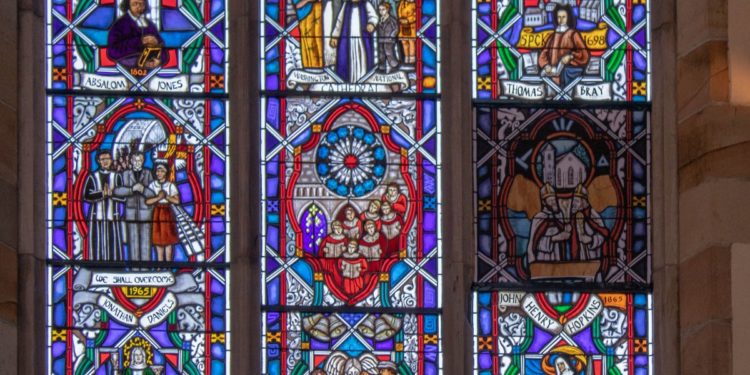Maggie Lorenzen
Executive Staff
On Monday, March 29, stained glass artists removed the stained glass panel of the Confederate and American flags on the previously named “Reconciliation” window in All Saints’ Chapel. It was replaced with the title “Reunification,” and the flags were changed to landscapes to match the different regions the flags originally represented.
The choice to replace the window is one of many re-evaluations, both within All Saints’ and across the University, of the presence of Confederate symbols on campus. The Rev. Peter Gray, University Chaplain announced the change on March 16, hours after The Washington Post reported on a “racial reckoning” at Sewanee that included the “Reconciliation” window as evidence that “the Confederate narrative is woven deeply into the backdrop of campus.”
This move preceded several piece-meal attempts to remove Confederate imagery from the Chapel, which Gray refers to as the symbolic “living room” of the University. In 1997, the University retired a mace bearing a Confederate flag, dedicating it to Nathan Bedford Forrest, that had been used in All Saints’ ceremonies since the 1960s. State flags were removed from the Chapel, removing several that bore elements of the Confederate flag. In 2018, a Confederate seal was removed from a stained glass window in the narthex of the chapel by previous University Chaplain Tom Macfie (C’80).
Gray, describes the previous window: “In the background, there’s a small church… and there are two Bishops, one Southern and one Northern. You know that is the case because over the shoulder of the Northern bishop is the flag of the United States of America, and over the shoulder of the Southern bishop is the Confederate battle flag.” The two figures are joining together, reconciling Northern and Southern Episcopal churches after the Civil War.
When explaining the importance of removing the symbol, Gray says, “This is where our welcome is extended. There is a window behind me that makes this welcome difficult, if not impossible.”
He clarifies the need to remove the symbol due to the harm it continues to perpetuate, as opposed to the history of the symbol in relation to the University’s past.
“[This is] the flag that flew over armies dedicated to the preservation of the enslavement of human beings in this country,” Gray says, “and a flag that in subsequent decades and centuries and even to this day continues to be used to terrorize, to intimidate.”
He asks, “How can we be a place of welcome with that racist symbol in our window? We can’t.”
In collaboration with the Roberson Project, Jessica Wohl, associate professor of art, facilities management, and Joan Williamson, whom the window was dedicated to, All Saints’ Chapel has been working for months to find an adequate and reverent replacement, according to Gray.
“In place of the flags, we’ll have landscapes.” Gray says. “Landscapes that evoke the regions of the country that are represented by the Bishops in the image. And also, while we’re at it, we’re going to take away the word ‘Reconciliation,’ because reconciliation requires amendment of life, repentance, and finding a new way forward.”
He continues, “In its place, will go the word ‘Reunification.’ Not a perfect term, but a more value-neutral term.” He says that this language is “so that this place can welcome the next generation of Sewanee students, and welcome those who are already here.”
According to Gray, this change had been in the works for the past several months, declining to comment on a direct relation to recent events of racial intimidation on campus.
Stacey Davidson (C‘95) says in an interview she has borne witness to many attempts to correct the University’s past.
“While I was a student at Sewanee,” Davidson says, “the state flags were removed from the chapel. The removal of the flags caused an uproar, but it was done because many of the states (most prominently my home state of Georgia) had the Confederate flag incorporated into their state flag.”
She continues, “There were also the beginnings of the conflict over the mace carried by the Order of the Gown president during convocation, which would eventually make news beyond The Domain. During my father’s time on the mountain, the decision to admit women was reached.”
Davidson also notes that, “As a 3rd generation Sewanee student hailing from a small Georgia town, those things never dawned on me at the time. Some 25 years later and wiser, I realize the fact it never dawned me is precisely the point.”
“The University itself must also be allowed to grow and change for new generations of students,” she says.
Credit: Source link




